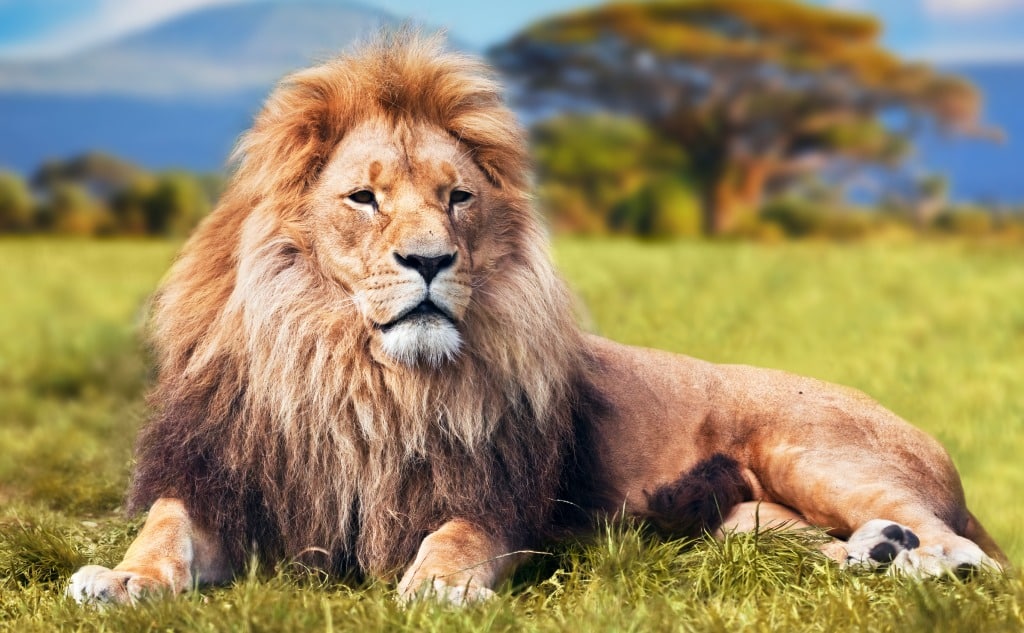This is whether lions eat plants.
It depends.
So if you want to know all the details about whether lions eat plants, then you’re in the right place.
Let’s get started!
Lions and Plants
Have you ever seen a cat chew on grass?
So, that means they can eat plants, right?
Well, yes and no, respectively.
In most cases, lions cannot eat plants because their digestive system cannot process plant matter.
Being exclusively a hypercarnivore, meaning meat is the largest component of their diet, lions have evolved with a carnivore-type digestive system that allows them to process and digest flesh, bones, and other bodily components.
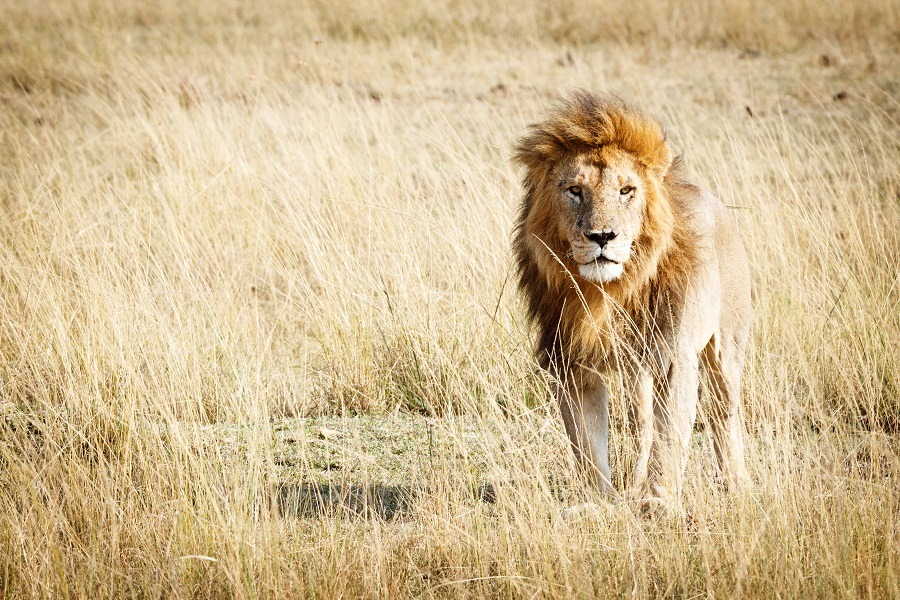
On average, a male lion eats about 15 pounds (6.8 kg) of meat per day, while a lioness eats 11 pounds (5 kg). But, in some cases, they can eat up to 66 pounds (30 kg) in one feeding session.
Before going into detail about why lions cannot digest plants, let’s compare three types of digestive systems:
- Herbivorous
- Carnivorous
- Omnivorous
Herbivorous Digestive System
Many mammalian animals are herbivores, which can digest plant material. Examples of herbivorous animals include, but are not limited to,:
- Deer
- Cattle
- Goat
- Sheep
These are classic ruminants, meaning they may chew and swallow their food, but it will come back up (regurgitate) to be chewed again. This is called chewing the cud.
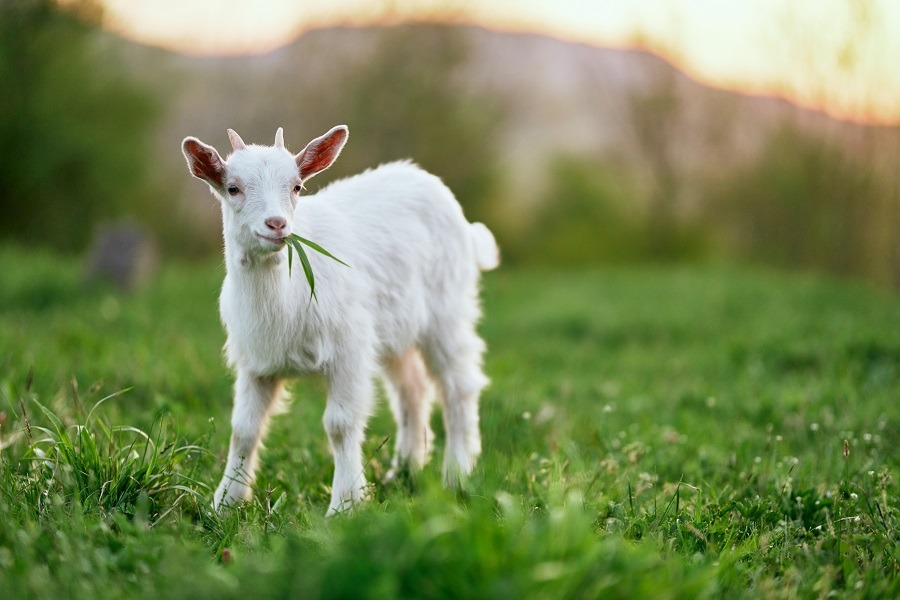
The teeth of herbivores are specialized for grinding and chewing vegetation. They lack canine teeth. Many herbivores, but not all, have stomachs with four compartments:
- Rumen
- Reticulum
- Omasum
- Abomasum
The rumen is the biggest stomach compartment. It can store the chewed vegetation for a long time. It is also where the fermentation process begins to break down structural bonds within the food to permit digestion.
There are many different types of bacteria and protozoa in the rumen that help break down plant food and aid indigestion.
An enzyme called cellulase breaks down cellulose, which is the main component of a plant’s cell structure and is found in most vegetation.
The reticulum functions like a filter, separating particles, allowing smaller particles to move forward into the next stomach chamber.
Larger particles remain in the rumen to be either regurgitated and chewed again or broken down into appropriately sized particles that can pass the reticulum.
The omasum is a mysterious organ because its function varies between different animals. It appears that in most applications, it is a place for the absorption of basic nutrients like water, minerals, and certain fatty acids. It also plays a part in fermenting the cellulose even more to weaken cellular bonds.
The abomasum compartment works exactly like our stomach. This is where the more complicated bonds found in proteins are broken down by the rennet (a type of enzyme) to facilitate absorption.
In addition, there are other non-ruminant herbivores such as rabbits, horses, and mice. They have a simple stomach consisting of one compartment like us.
Herbivores can also be further classified into fruit eaters, leaf eaters, and nectar eaters.
Carnivorous Digestive System
This type of digestive system is adapted for processing meat and bones. Meat is easy to digest, and these animals have a short gastrointestinal tract (GIT).
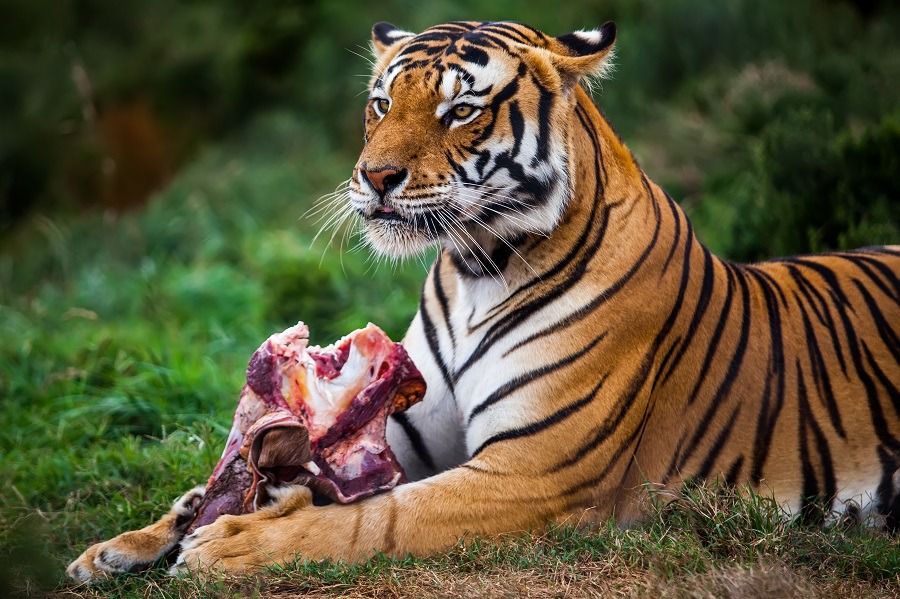
All felids, that is cats, are exclusively carnivores, meaning they eat only flesh and organs of other animals. As a result, they cannot synthesize some of the major nutrients, such as retinol (vitamin A), arginine (a type of protein-amino acid), and taurine (a type of protein-amino acid), and thus require meat as a concentrated source of these substances.
Non-exclusive or facultative carnivores, such as dogs, eat meat along with plant or grain food.
Omnivorous Digestive System
Omnivores are flexible eaters with characteristics of both herbivores and carnivores. Their digestive system is adapted for both types of food but does not incorporate extremes of either type.
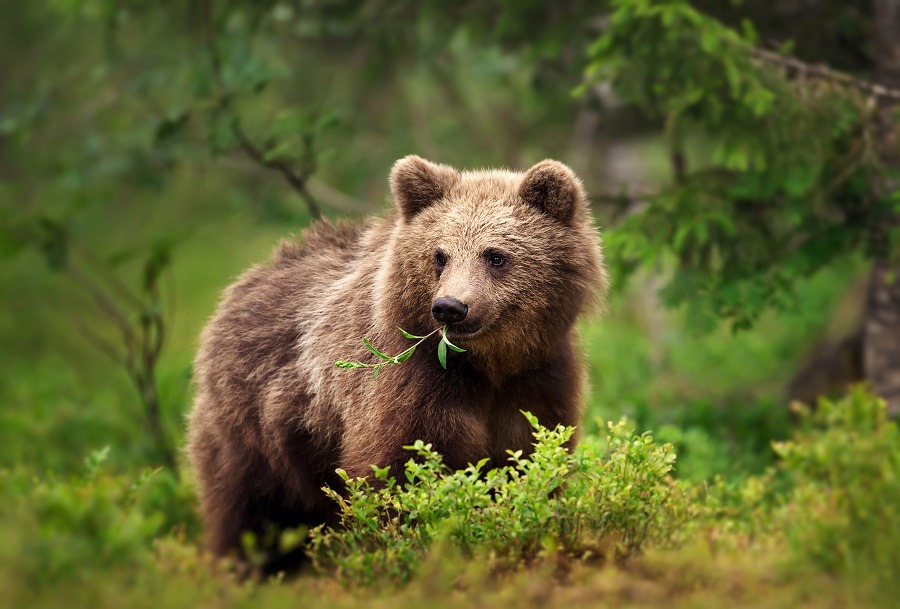
The key is they have teeth for grinding as well as cutting. The omnivorous mode of nutritional access is one of the most successful adaptations for survival on Earth. Examples of omnivores include:
- Humans
- Pigs
- Badgers
- Mice
- Bears
Why Lions Cannot Digest Plants
Below we will discuss more in-depth some of the limitations of a lion’s digestive system to explain why it cannot digest plant matter.
Cannot Grind Plant Material
The most important tool to break down plant matter is our teeth, especially the molar and premolar teeth.
Plants matter must be ground between the large surfaces of molar teeth before swallowing to begin the process of breaking down the cellulose fibers. Think of these teeth as millstones grinding grain into flour to help illustrate this point.
Similarly, the type of teeth that are designed to cut and tear flesh are canines. Think of them like two little knives, both top, and bottom that help a carnivore or omnivore tear flesh apart.
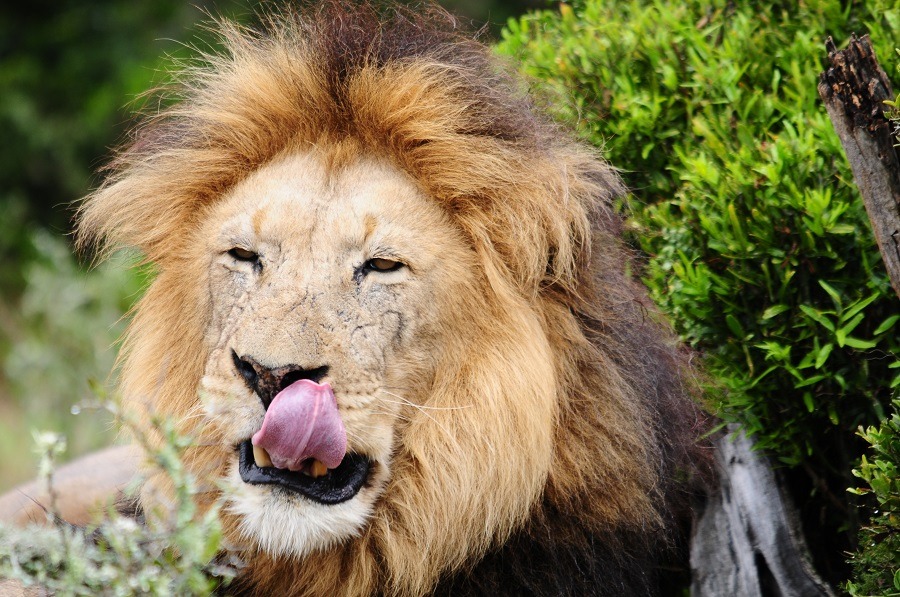
Then, there are incisors which are usually located at the front of the mouth. They are used for cutting and scraping.
If you do woodworking, these teeth work like a plane does by scraping strips of wood off the surface. But, they are also good for cutting as an ax does. This is why rodents, like beavers, have such large incisors because they need them to cut and scrape trees to eat and to build their homes.
Here is a chart to show you the types and numbers of teeth for the three types of digestive systems. The backslash divides upper and lower teeth.
Notice that lions have only one pair of molar teeth, which means they cannot truly grind vegetation effectively. However, this one set of molars also serves a different purpose.
What is important to note here is the dental arrangement and shape of any animal are related to its diet. Molar shapes differ per the animal’s particular needs. Thus, the premolars and molars of the lions are sharp and are designed to break and crush bones.
Lions Cannot Break Down Cellulose
A plant-based diet contains a large amount of cellulose which is the main structural component of its cellular wall.
Herbivores such as goats, sheep, cattle, and so forth have an efficient microflora (a collection of bacteria and protozoa in their digestive tract) that produce an enzyme called cellulase that breaks down cellulose.
Even herbivores with simple stomachs, such as horses, have small microflora in the caecum (the large intestine) to assist with the fermentation and breakdown processes. Ruminal microflora is also responsible for softening of food as well.
Lions have none of this digestive infrastructure and therefore cannot break down cellulose. This limits their ability to digest plant matter.
Lions Cannot Regurgitate
Plant-based diets have a low nutritional value. Thus, herbivores need to make the most of the situation and ingest large quantities of plant matter to meet their nutritional needs. So, herbivores ingest a great deal of plant matter in a very short time.
However, they then take a long time digesting it because they need to thoroughly break the plant matter down to be sure to get all of the nutrition they can from it. This requires them to chew it multiple times. They do something called “chewing the cud.”
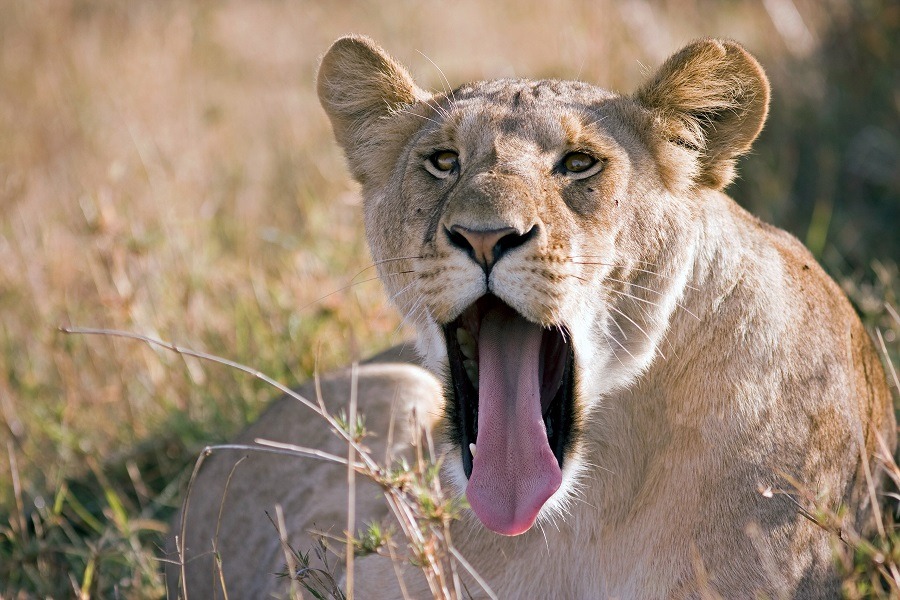
This is how it works. They store plant matter in the first chamber (rumen), where fermentation and breakdown begin. Then, what does not get through the filter (reticulum) gets regurgitate back into the mouth for a “re-chew.” This re-chewing helps these animals to ingest a large quantity of plant matter when available and then digest it later, as needed.
A lion’s digestive system is unable to regurgitate or re-chew such a plant-based diet.
No Salivary Amylase in a Lion’s Saliva
Through millions of years of evolution, lions have been adapted to a true, or obligative, carnivore diet.
Because they do not need carbohydrates, they do not have an enzyme called salivary amylase or ptyalin, a starch digesting enzyme.
At the same time, herbivores and omnivores require carbohydrates in their diet and therefore have this enzyme.
Lions Have a Very Small Caecum
The caecum is a sac-like part of the large intestine, often located where the small intestine meets the large intestine.
For simple stomach herbivores, such as horses, have a functional caecum and ferment the food because they don’t have a rumen. As a result, their caecum contains microbes similar to ruminants.
Lions have a very small caecum, even smaller than omnivores, which cannot ferment plant-based food.
Lions Have Very Short Small Intestine
The digestion of protein to smaller peptides (building blocks of amino acids-proteins) occurs in the stomach.
The digestion of polypeptides to amino acids and the absorption (transfer of nutrients into the blood) occurs in the small intestine.
Lions have a very short small intestine as compared to herbivores of comparable size. This short length of the small intestine is not efficient in completing the digestion and absorption of plant matter. Remember, the herbivore diet contains fewer nutrients per volume compared to a meat-based diet.
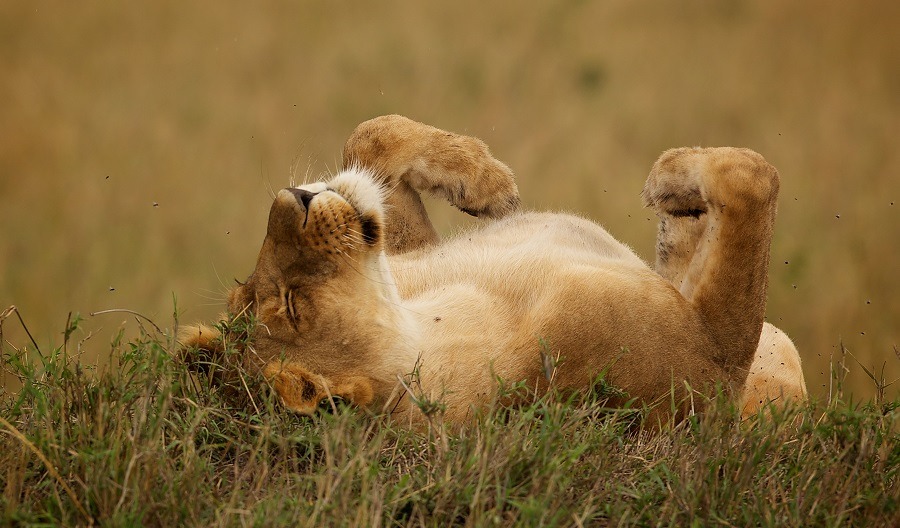
With this short small intestine, lions cannot digest and absorb the nutrients of the plant matter effectively.
However, this short intestine is all they need to absorb protein found in their meat-based diet since meat is so easy to digest.
Lion’s Stomach Is Unable to Digest Vegetation
Lion’s stomach is specially designed to digest a meat-based diet. They eat flesh, organs, skins, hooves, bones, and other animal materials, which are easily digested by low pH (highly acidic), high HCl (high chlorine content), and special gastric (stomach) enzymes. A lion’s stomach also serves the purpose of absorption and storage of food.
Vegetation Is Less Nutritious
Plant-based diets are less nutritious, with maybe the exception of fruits. Meat, on the other hand, contains a concentrated source of nutrients. Therefore, lions prefer a meat-based diet that helped them in their survival by maximizing nutrient intake.
What Happens When Lions Eat Plants?
Lions and other carnivores can swallow plant matter, but most will immediately vomit it back up.
This is because their stomach rejects the plant matter.
Lions Have Been Seen Chewing Grasses and Other Vegetation – What Going On?
Lions chew grasses and other plant materials usually when their digestive system is not working well. Think of it as a purgative, something that promotes vomiting or cleans out the digestive tract.
Sometimes they lack certain vitamins or minerals, such as folic acid, which they need for growth. This acid is present in large amounts in certain plants.
So, the bottom line is lions are apex predators and are adapted to an exclusively carnivorous diet.
They cannot eat plants because their GIT cannot digest them effectively.
On rare occasions, lions may chew on vegetation to vomit or get much-needed minerals and vitamins.
